Stocks Market Talks, Few Listen - Profit Is The Only Objective
Stock-Markets / Stock Markets 2013 Nov 17, 2013 - 02:54 PM GMTBy: Michael_Noonan
 What if you had someone, or something, to act as a reliable advisor telling you what to buy and when, and also how to manage your risks? Would you pay attention? Who would say "No" to such a proposition? Yet, almost everyone does ignore the source. Instead, people listen to brokers, [foolish]talking heads on financial networks, or whatever other source one may choose for advice or direction.
What if you had someone, or something, to act as a reliable advisor telling you what to buy and when, and also how to manage your risks? Would you pay attention? Who would say "No" to such a proposition? Yet, almost everyone does ignore the source. Instead, people listen to brokers, [foolish]talking heads on financial networks, or whatever other source one may choose for advice or direction.
The best and most reliable source is the market itself. It provides all available information from all available sources condensed into a bar, depicting the open, high, low, and close of whatever time frame one chooses: intra day, daily, weekly, monthly, annually, etc. What is interesting about this is that the information is available to everyone, at the same time any price is executed in the marketplace.
The information cannot lie because it is based on factual executions. When coupled with volume, the developing picture takes on an added dimension. If this does not capture your interest, then move on to some other source and ignore what follows. If growing your capital and reducing it to risk exposure is a worthwhile goal, then what follows is a simpler way to navigate an otherwise difficult financial terrain.
If you were to go on a trip, would you first consult a map for directions, or use a GPS to get you from point "A" to point "B?" If walking in the woods, would you follow a path or cut through the forest, hoping to get to where you want to go? The answers seem so obvious, but when it comes to the stock market and putting capital at risk, so many are willing to do it blindly, without concrete direction, or rely on someone else.
There are eight charts that follow. The first two are of the S&P. The remaining six are of individual stocks, randomly chosen as examples of how to relate decision-making to the market itself. The premise is that the markets send very clear messages, all the time. We qualify that last sentence with first having a defined set of rules for engagement in the markets. With rules, execution is automatic, for the most part. Without rules, one has no map, no GPS, no plan. Caveat emptor.
A lot of people ignore charts, mostly due to a lack of understanding/appreciation for them. Their eyes glaze over. However, there is a common sense way to view them, step-by-step, and if one takes that more open approach, charts become less intimidating.
Markets are not akin to gambling, unless by [lack of]choice. Firstly, you do not have to place money at risk unless you choose to do so. Secondly, and most importantly, you get to choose when and at what price you determine before choosing to participate. If your rules are not met, then there is no reason to commit any money. The objective is to grow one's capital and manage risk, at the same time.
The importance of having rules is that they are based upon previous market set-ups that have a proven positive outcome, on balance. There is no guarantee of a positive outcome on every trade decision, but by following the known pattern of behavior, over a series of trades, the net outcome will be positive. We know this to be true based upon the laws of probability.
You do not have to understand all the details and nuances of charts. The point is to get you to look at what you own, compare it to what the market is doing, and then make an informed decision about what you have in your portfolio and if it belongs in it. This is a way to get you to be more active in decision-making and ultimately, more profitable.
First, a look at the general market:
The trend is the most important information you can have about any market. If the trend is down, for example, why would you want to buy something that is declining? If the trend is up, then you want to find the best of the best possible candidates in which to take a position. Committing money to anything less is acknowledging you are willing to accept mediocrity and increased risk [loss] in capital. It may seem like an elementary premise, but too many accept a lack of rules in their market approach.
Here is rule #1. Trade only with the trend.
The trend is clearly up, and that means to only trade/invest from the long side. It cannot be any simpler. There are also no signs of ending action, or activity that would threaten an end to the trend.
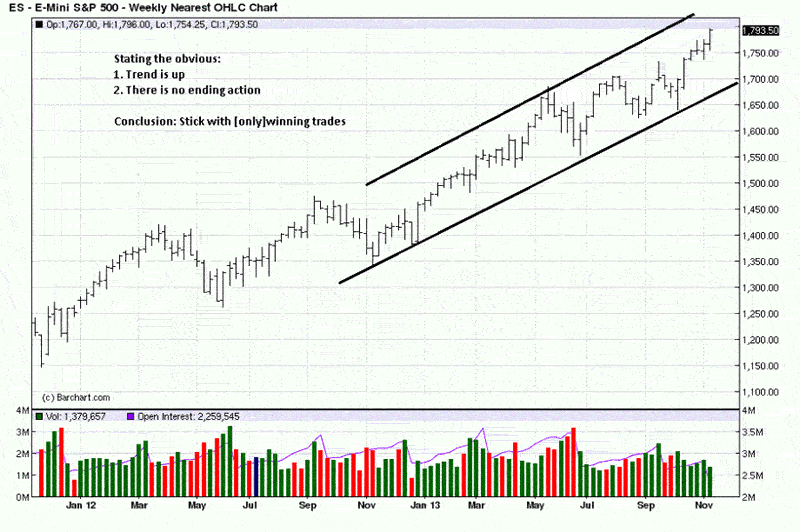
There was a new high breakout in mid-October, a point in time from which the individual stock charts will start, when we get to them. After the breakout, there was some sideways activity, at the end of October, early November, and then the up trend resumed.
The shakeout low in November left behind a higher swing low, relative to the last swing high in September. That space left behind is called "bullish spacing." It is an indication of underlying strength in the trend. Why? It tells us buyers were willing to buy before seeing how the September high would be retested. It is a measure of buyer confidence, and a piece of market information you have in understanding the character of the trend.
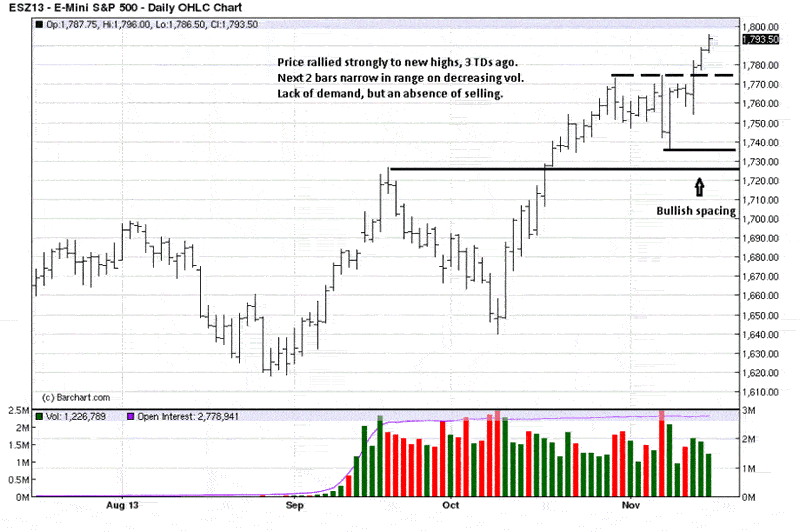
For the sake of simplicity, one of the rules is to only buy stocks showing an ability to break out of an established trading range, [TR], within the known market up trend. Price history prior to mid-October will be ignored.
We know the market is trending up. A look at TJX shows it breaking out of a TR prior to the index. Already, we have evidence that TJX is relatively stronger than the general market, and this added market information is a huge plus.
The next rule is to place a buy stop just above the high of the trading range. If price rallies to trigger the buy stop, the decision to buy is now automatic per established rules. You are not confronted with "Should I buy this here, or not, or wait to see...etc" The decision has already been made. It then becomes a matter of entering a sell stop and managing the risk.
Note how the angle of price appreciation is stronger than the S&P. This stock is stronger than the overall market. Our rules have picked one of the "best of the best" to commit capital in a concerted effort to have it grow.
You now see how a few simple rules have made decision-making a function of the market and its proven strength that puts the odds of success in your favor.
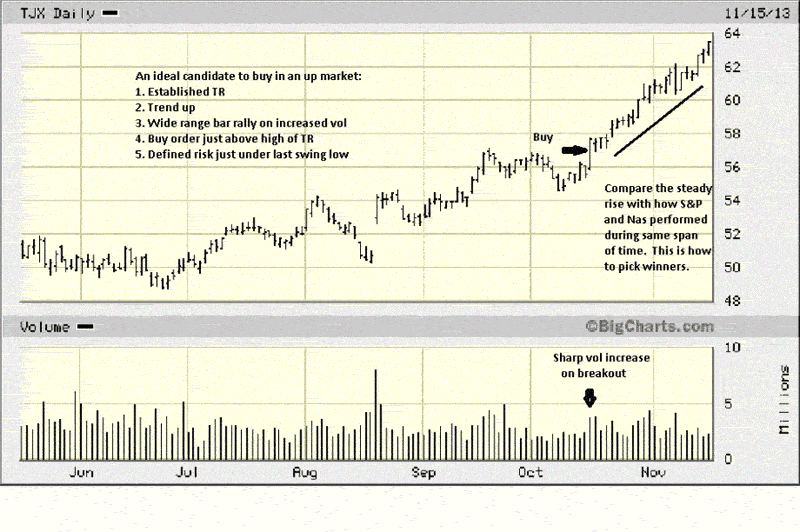
SSYS did not trigger until the end of October. It met the criteria of the few rules for buying into a trending market. SSYS is also stronger than the general market, noted by its rally effort throughout November, whereas the S&P paused during the first part of the month. Once again, we see relative strength in the selection, and the stock is up about 10% since entry in just a few weeks.

There was no breakout in DE. In fact, while the overall market was rallying, DE was in a state of decline. There are a great number of people who have been buying DE since the middle of October, but you can now ask yourself the question, "Why?"
Why buy something that has proven an inability to trend with the overall market when there are other stocks, [TJX, SSYS] that are clearly a better choice? Perhaps the buyers are hoping to buy a bargain. We are not interested in "bargains." We only want quality trades, for a reason. Because DE failed to trigger, based on rules for buying, there was never a need to consider making a decision that would have proven to put capital at almost certain risk and greater potential for loss.
Based on this little exercise, so far, which stocks would you consider buying? With a few simple rules, common sense becomes the order of the day, not guesswork or even indecision.
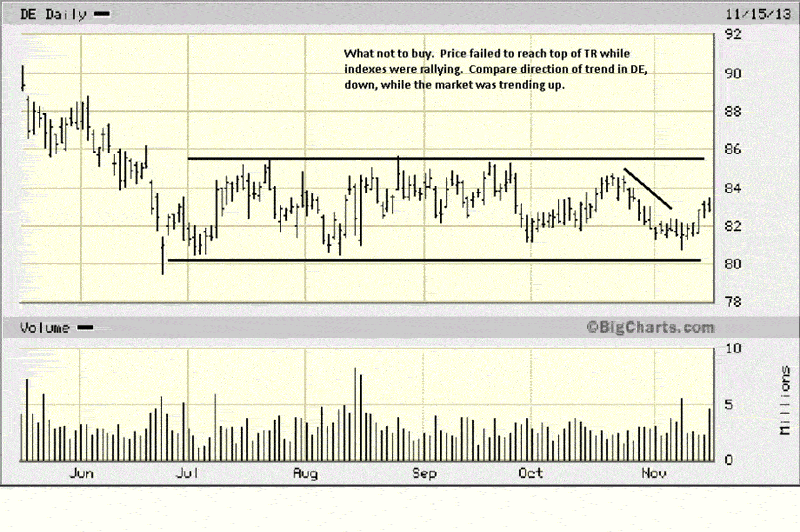
The rules said to buy AAPL, automatically on the breakout, as indicated. We said the market sends messages, some clearer than others, and we see a huge red flag, six TDs [Trading Days],after entry. It is an OKR, [Outside Key Reversal - a new high, followed by a lower low, relative to the previous day, and in this instance, a lower [poor]close, on increased volume.
The market's "message?"
Sellers entered the market and overwhelmed buyers, pushing price lower after making a recent new high. This is a negative development while the general market is still trending higher. It is an indication to move the stop to just under the buy day, or simply stand aside and say, "This is not how a quality stock should act." You can see how price has since moved sideways while the overall market reached new highs.
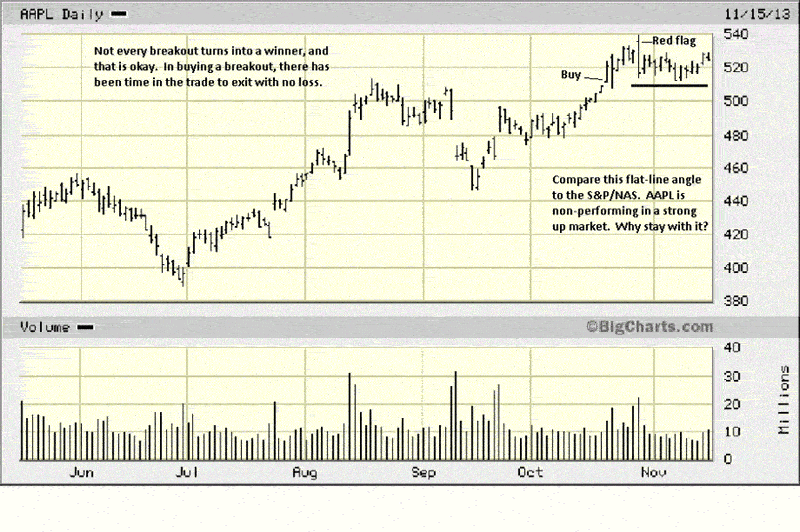
Facebook, FB, is not the best example of a quality trade, but it helps to see what can occur when rules are diluted, or worse, ignored.
An automatic decision to buy is triggered when price rallies above the TR high. Next day, price gaps higher, adding confidence to the trade selection. However, there is a steady decline from the 3rd TD on. Was there a sign from the market to exit?
Next chart.
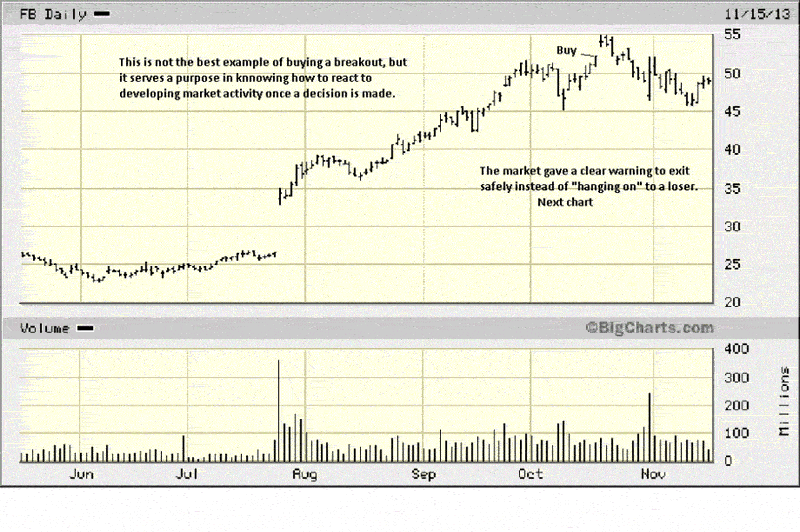
This is a more detailed look at what developed. We know from the buying pattern, using breakouts from a TR, the probability of a successful outcome is greater than not. That means not every trade will work. This part of the analysis requires some more detailed knowledge in reading developing market activity, but the market did "talk" and send a clear message.
At 1, there is a lack of follow-through on a small range day. Not a big deal. At 2, we see a wide range bar to the downside on increased volume and a poor close. This is another Red Flag message, an immediate alert that the stock is not acting well, especially when the overall market is trending higher.
One could exit here, for a very small profit, which is not the point, or move the stop up to under the low of the breakout day. [Taking relatively small losses is okay.] We see the next 3 TDs are small ranges, and that is indicative of a lack of demand. The 3rd TD after the Red Flag event fails to rally even half-way into the range of #2, and it closes poorly. There is no question that this stock has failed to maintain the "best of the best" quality effort, and it is definitely time to exit. No harm done on a trade that did not work out.
Are the markets random? Absolutely not! Only to those who do not understand them and decide markets are because of "randomness" of their limited beliefs. Can money be made consistently? Absolutely. You just saw a few examples of how.
The question for you to ask, moving forward is, do I want to make money or conduct "business as usual?" Smart money operates from established rules, and if the market does not conform to what can be your rules, then you have no reason to be engaged in the market. Profit is the only objective. Using rules accomplishes that goal.
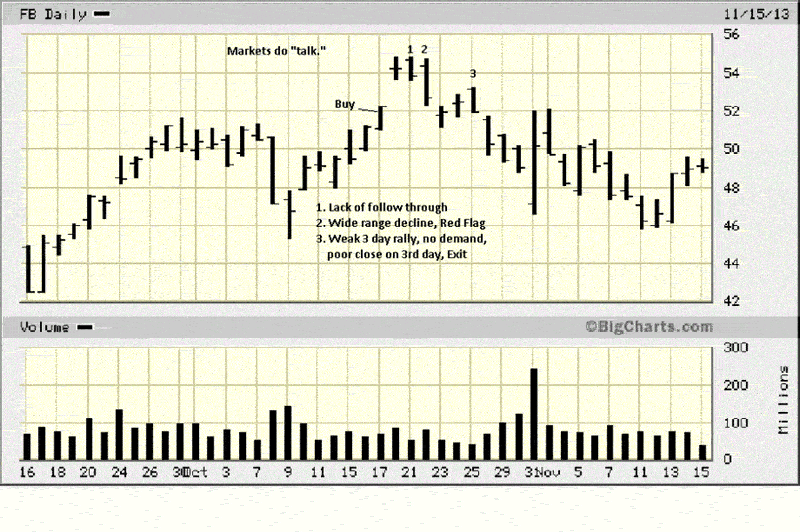
By Michael Noonan
Michael Noonan, mn@edgetraderplus.com, is a Chicago-based trader with over 30 years in the business. His sole approach to analysis is derived from developing market pattern behavior, found in the form of Price, Volume, and Time, and it is generated from the best source possible, the market itself.
© 2013 Copyright Michael Noonan - All Rights Reserved Disclaimer: The above is a matter of opinion provided for general information purposes only and is not intended as investment advice. Information and analysis above are derived from sources and utilising methods believed to be reliable, but we cannot accept responsibility for any losses you may incur as a result of this analysis. Individuals should consult with their personal financial advisors.
Michael Noonan Archive |
© 2005-2022 http://www.MarketOracle.co.uk - The Market Oracle is a FREE Daily Financial Markets Analysis & Forecasting online publication.



